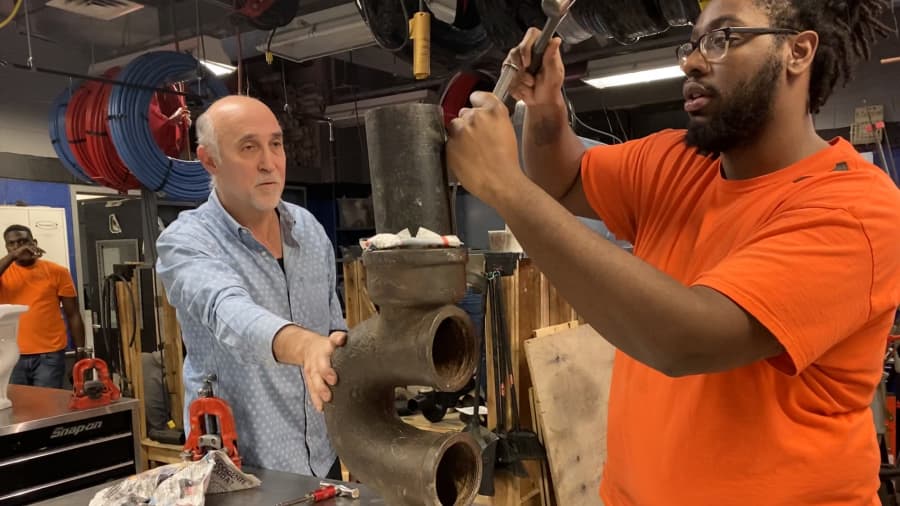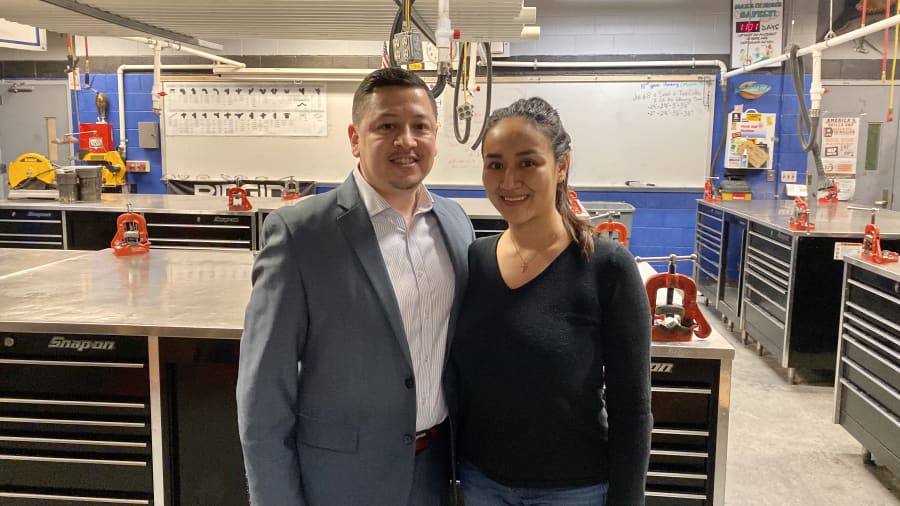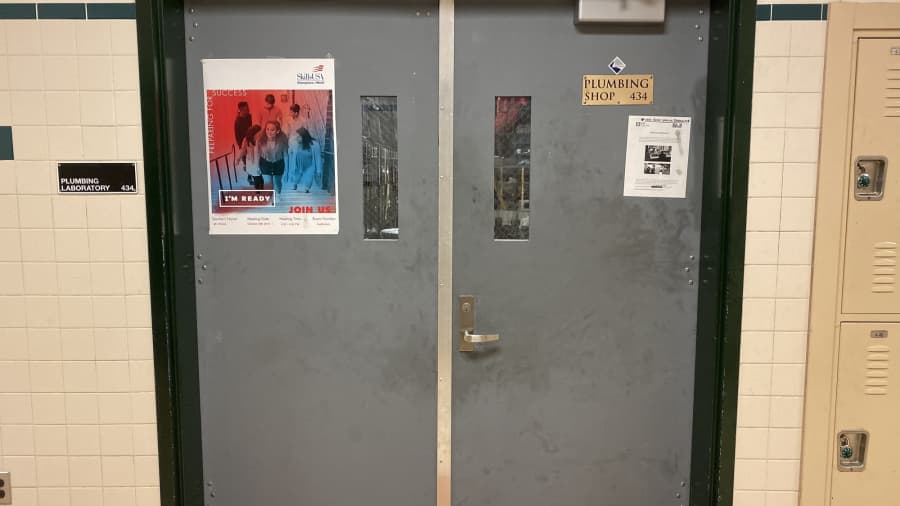
As the cost of college has steadily risen over the past several decades, students across the country are beginning to question if earning an advanced degree is worth it.
While research still consistently shows that earning a college degree leads to higher lifetime earnings and lower rates of unemployment, prominent figures in business have begun vocally proposing an alternative — trade school.
“I don’t recommend college for everybody,” Kevin O’Leary, star of ABC’s, “Shark Tank,” told CNBC Make It in May of 2019.“The fact is, there’s a lot of trade schools that would help you make a lot more money.
“Be a plumber, they get rich. Everybody has to have a plumber, even in a recession,” he says. “Every single building on Earth wants to have electricity and plumbing working… These are careers that actually can help you provide for your family forever.”
Businessman-turned-politician Michael Bloomberg has also offered similar advice. “Today if your kid wants to go to college or become a plumber, you’ve got to think long and hard,” he said at the 2014 annual meeting of Wall Street trade group SIFMA.
“If he’s not going to go to a great school and he’s not super smart academically but is smart in terms of dealing with people and that sort of thing, being a plumber is a great job because you have pricing power, you have an enormous skill set.”
Representatives for his presidential campaign confirmed to CNBC Make It that Bloomberg still believes in the power of skills-based trade school.
And many other politicians across the political spectrum from Bernie Sanders and Elizabeth Warren to Donald Trump have voiced support for technical schools.
So does becoming a plumber live up to the hype? CNBC Make It spoke with plumbers, students and administrators about the costs of training, how much plumbers really earn and what it’s like to work in the profession.
We learned that going to trade school to be a plumber isn’t necessarily as easy, cheap and profitable as some have promised. But it can be a smart investment for those who want to work in the field.
Costs of training programs can vary widely, and the payoff depends on your job title and where you live.
According to the Bureau of Labor Statistics, the median pay for plumbers, pipefitters and steamfitters was $25.92 per hour and $53,910 per year in 2018. In New York, the median wage for plumbers is closer to $76,410.
What’s more, it’s difficult, physical work.
There’s a reason wealthy parents typically send their children to prestigious — and often expensive — colleges and universities: Earning a college degree from a reputable institution remains one of the most profitable investments that workers can make.
Here’s what we’ve learned about what it really takes to become a plumber:
The process of becoming a plumber
Many plumbers have engineering backgrounds, and the wealthiest plumbers can often be more accurately categorized as business owners who, after working as plumbers for several years, started their own businesses that employ several other plumbers.
Importantly, there is a wide range in the cost and quality of trade schools, impacting how much the return on an investment in trade school may be. For-profit programs can often cost more than traditional colleges, while many public universities offer affordable options with low costs that can be hard to beat.
For instance, Apex Technical School’s 30-week undergraduate certificate program for plumbing and pipefitting costs $17,816 for tuition and fees and $590 for books and supplies. The New York-based program’s website says that students typically graduate with $11,150 in debt and pay monthly loan payments of about $115 per month with an interest rate of 4.45%.
These costs are higher than the average four-year public university.
During the 2018-2019 school year, the published tuition and fees for full-time, in-state undergraduate students at public four-year colleges was about $10,230. When room and board are included, this figure increases to $21,370. The College Board reports that students who go to public universities receive an average total of $6,490 in grant aid and tax benefits, bringing the net cost of public university for these students down to $14,880 per year.
For-profit schools such as Apex are required by the Department of Education to disclose student outcome information, which reveals that 46% of students who qualify for federal financial aid funds (known as Title IV students) graduate from the program within its duration of 30 weeks.
Among the students who do graduate,just 67% of program graduates got jobs, according to the New York job placement rate.
Steve Markowitz, president of Apex Technical College, says a big appeal of the program is its expediency.
“Most of our students that take this program, they want to go to work as soon as possible,” he tells CNBC Make It. For instance, “If they take our welding program, it’s all just welding. We just give them what they need to get an entry-level position. And if they will go to a four-year school, they’d be out of school and then have three and a half years’ salary and experience already by the time they first be graduating. And that’s very appealing to a lot of students.”
LaGuardia Community College in New York offers a 14-week plumbing course for $2,239, including books and fees. At the end of the course, students receive their OSHA 30 certification and their plumbing level one certification, and their construction core certification from the National Center for Construction Education and Research — credentials needed to secure a job as a plumber in New York.
David Daza, who oversees the plumbing, electrical and veterans workforce initiatives for LaGuardia, says students cannot take out federal financial aid or loans for the program.Typically, students pay out of pocket, he says.
“College is expensive, and for most people even courses like this that are more affordable than the Apexs and stuff, it’s still $2,000 that people don’t have in their pockets all the time,” says Daza. “So we offer payment plans for our students so they can break up the tuition for those three months or so as they’re going through the program, and then pay monthly.”

David Daza and Natalie Kavral.Photo by Abigail Hess
The experience of being a plumber
Natalie Kavral, a former nursing student, teaches aplumbing class at Laguardia Community College.
Kavral estimates that she spent roughly $25,000 on two years of nursing school, including tuition, books and transportation before she admitted to herself that she couldn’t handle the sight of blood, no matter how passionate she was about medicine.
Instead, Kavral became a plumber, eventually working for four years as part of a plumbing union. She says she earned $40 per hour working as a plumber, but when she learned about the opportunity to teach, she jumped.
“I love the theory of plumbing. I hate the cold, the heat and the physical demand. [Teaching] was my opportunity to stay within my field, but do it differently,” says Kavral. “I took the opportunity and I was like, ‘You know what, if it doesn’t work out, I’ll go back to the union.’”
The promise of a stable, well-paying union job is a big appeal for her students, says Kavral, adding that she has heard of plumbers making as much as $60 an hour in New York.
Daza says that since the plumbing program launched two years ago, graduates have reported hourly wages between $15 and $24 per hour, “depending on the employer, the individual and their experience,” he says. “But certainly after a few years of experience, they could be onto the next bracket. Definitely there is a lot of potential for good wage earnings.”
Because the program is relatively new, the LaGuardia program does not have the same level of statistics made available as those from Apex.
Slowly, students trickle into the classroom named Plumbing Shop 434.
“I tell my students, even the ones that they’re like, ‘School’s not for me.’ I tell them, ‘Once you start to see the money that comes in, and then you find out you can make more, you’re not going to want to stop,’” says Kavral. “They come here and they bust their butts, coming here after a long day of work to sit from 4:30 to 9:30. They’re doing it because they want more money.”
One of Kavral’s students, Cameron Duncan, says that was the case for him.
“I went to college, but I never finished,” he says. “And right after college, I went straight to work. I was a janitor and I was like, ’Since I’m here, I might as well find a trade to get into, get involved in it, make myself and make a big living out of it.”
Duncan says he studied psychology at Tompkins Cortland Community College for four years and came up a few credits short of graduating — a circumstance most college students can relate to.
According to the National Center for Education Statistics, just 41% of first-time full-time college students earn a bachelor’s degree in four years, and only 59% earn a bachelor’s in six years.
“I wish I actually found this school in high school,” says Duncan.
Other students in Kavral’s class include author Richard Zacks, who says he took six years to graduate himself and is taking the class as a passion project, alongside students who are full-time Uber and Lyft drivers hoping to find a steady career.
A military veteran himself, Daza says the program has attracted a number of veterans.
“Veterans tend to be more hands-on,” he says. “I think this is a good fit for veterans. I think it’s a good fit for a wide range of people. There is no typical student for this program.”
Kavral says that while the majority of her students are men, they come from all walks of life. And while most directly enter the plumbing profession, others follow more unique paths.
“A lot of people have that idea and that interpretation of ‘Just because I chose a technical training means that I can’t go to college.’ I tell them this is just a start to your education. You’re just planting the seeds,‘” she says. “You could learn the trade, you could go work, you could go to college. For some of my students, they’re politicians and they’re business people and they say ‘I might not work hands-on for five, 10 years, but I could probably partner up and help someone run a business.’”

The door to plumbing shop 434Photo by Abigail Hess
Doing the math
There is a basic equation that experts recommend students use to make decisions about these kinds of educational investments.
“As students look at the equation for how much they should borrow when they go to college, they ought to be thinking of the total debt that they take on as not being more than 10 to 15% of what their earnings are going to be when they leave college,” Michael B. Horn, co-founder of the Clayton Christensen Institute, tells CNBC Make It. “You really want to be mindful that you’re not crossing that threshold of payments that are just going to crush your income because they’re taking up, say, 20, 30% of your monthly paycheck. If you’re in that realm, you’re going to have problems in the long run.”
Depending on the program, going to school to become a plumber may satisfy this simple equation. But as with most important life decisions, there are other variables to consider. Namely, do you want to be a plumber? Do you want to do the physically demanding work being a plumber can entail?
Jon Marcus, higher education editor at The Hechinger Report has covered the issue of trade school for years. He says that students should be encouraged to think about why they want to go to a traditional college before they make a potentially expensive decision and that they should also be open to other options, including plumbing programs.
“I’ve met a lot of people in those programs and they’re laughing all the way to the bank right now,” he tells CNBC Make It, pointing to his work covering ironworkers, who he says can make $50,000 a year at the age of 18. “Now, having said that, I’ve also met a lot of people who 20 years later, after working as an ironworker, their bodies are beaten down and they only have some post-secondary education… 20 years from now, when you don’t want to be climbing up scaffolding anymore, then what do you do? That’s the problem.”